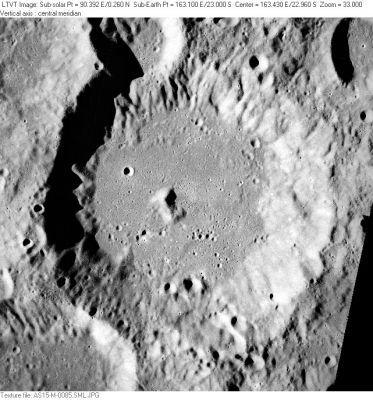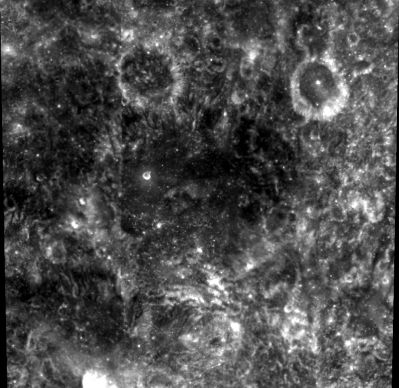Difference between revisions of "Paracelsus"
| (One intermediate revision by the same user not shown) | |||
| Line 4: | Line 4: | ||
| Lat: 23.0°S, Long: 163.1°E, Diam: 83 km, Depth: 4 km, Rükl: ''(farside)''<br /> | | Lat: 23.0°S, Long: 163.1°E, Diam: 83 km, Depth: 4 km, Rükl: ''(farside)''<br /> | ||
|} | |} | ||
| − | [http://www.lpod.org/coppermine/albums/userpics/Paracelus_AS15-M-0085_LTVT.JPG [[Image: | + | [http://www.lpod.org/coppermine/albums/userpics/Paracelus_AS15-M-0085_LTVT.JPG [[Image:Normal_Paracelus_AS15-M-0085_LTVT.JPG|external image normal_Paracelus_AS15-M-0085_LTVT.JPG]]][http://www.lpod.org/coppermine/albums/userpics/paracelsus-clem1.jpg [[Image:Normal_paracelsus-clem1.jpg|external image normal_paracelsus-clem1.jpg]]]<br /> ''Left: [http://lpod.org/coppermine/displayimage.php?pos=-2052 Apollo 15] Right: [http://lpod.org/coppermine/displayimage.php?pos=-1152 Clementine]''<br /> <br /> <div id="toc"> |
==Images== | ==Images== | ||
| Line 18: | Line 18: | ||
** Position : 22.96°S, Long: 163.43°E; Diameter: 81 km; Depth : varies from 3 to 5 km (LM-103; depth confirmed by shadows) | ** Position : 22.96°S, Long: 163.43°E; Diameter: 81 km; Depth : varies from 3 to 5 km (LM-103; depth confirmed by shadows) | ||
** Central peak height : 860 m (from shadow, agrees with LM-103) | ** Central peak height : 860 m (from shadow, agrees with LM-103) | ||
| − | * (for further details of the topography see the red-blue 3D stereo Apollo 15 images of [http://www.flickr.com/photos/ltvt/998629541 Paracelsus] and its [http://www.flickr.com/photos/ltvt/998629487/ central peak] made by combining [http://apollo.sese.asu.edu/METRIC_PREVIEW/AS15-M-0085/AS15-M-0085.html AS15-M-0085] with [http://apollo.sese.asu.edu/METRIC_PREVIEW/AS15-M-0084/AS15-M-0084.html AS15-M-0084]) <span class="membersnap">- | + | * (for further details of the topography see the red-blue 3D stereo Apollo 15 images of [http://www.flickr.com/photos/ltvt/998629541 Paracelsus] and its [http://www.flickr.com/photos/ltvt/998629487/ central peak] made by combining [http://apollo.sese.asu.edu/METRIC_PREVIEW/AS15-M-0085/AS15-M-0085.html AS15-M-0085] with [http://apollo.sese.asu.edu/METRIC_PREVIEW/AS15-M-0084/AS15-M-0084.html AS15-M-0084]) <span class="membersnap">- JimMosher</span> |
* [[Central%20peak%20composition|Central peak composition]]: A & GNTA1 ([[Tompkins%20%26%20Pieters%2C%201999|Tompkins & Pieters, 1999]]) | * [[Central%20peak%20composition|Central peak composition]]: A & GNTA1 ([[Tompkins%20%26%20Pieters%2C%201999|Tompkins & Pieters, 1999]]) | ||
<br /> | <br /> | ||
Latest revision as of 20:29, 16 April 2018
Contents
Paracelsus
| Lat: 23.0°S, Long: 163.1°E, Diam: 83 km, Depth: 4 km, Rükl: (farside) |


Left: Apollo 15 Right: Clementine
Images
LPOD Photo Gallery Lunar Orbiter Images Apollo Images
AS15-M-0282 shows bright craterlet Paracelsus N near the photograph's left margin. In it (in Paracelsus N) there's noticeable reflected light on its western inner shadowed slopes.
See also LAC 103 (page 206) in the Clementine Atlas of the Moon
Research Danny Caes.
Maps
(LAC zone 103B4) USGS Digital Atlas PDF LM map
Description
Description: Wikipedia
Additional Information
- Data from LM-103 and AS15-M-0085 calibrated to 1994 ULCN
- Position : 22.96°S, Long: 163.43°E; Diameter: 81 km; Depth : varies from 3 to 5 km (LM-103; depth confirmed by shadows)
- Central peak height : 860 m (from shadow, agrees with LM-103)
- (for further details of the topography see the red-blue 3D stereo Apollo 15 images of Paracelsus and its central peak made by combining AS15-M-0085 with AS15-M-0084) - JimMosher
- Central peak composition: A & GNTA1 (Tompkins & Pieters, 1999)
Mystery at Paracelsus C
- For orbital close-up photographs of the two odd objects on the southern part of the floor of Paracelsus C, visit the page Stratification.
Nomenclature
Paracelsus [Philippus Aureolus Theophrastus Bombast von Hohenheim] (November 11, 1493 - September 24, 1541) was an alchemist, physician, astrologer, and general occultist. Paracelsus was sometimes called the father of toxicology. He said that substances often considered toxic can be benign or beneficial in small doses, and conversely an ordinarily benign substance like water can be deadly if over-consumed.
Rima Paracelsus M (see Vallis Alpha Reed below).
Vallis Alpha Reed
South-southeast of Paracelsus M (at the most northern part of the Ingenii Basin) runs a rille which was once unofficially known as Vallis Alpha Reed (this during the hey-days of NASA's Apollo project). Vallis Alpha Reed is mentioned in David Woods' and Frank O'Brien's Apollo 15 Flight Journal, at 81:15:41 GET in the mission.
The meaning (and origin) of "Alpha Reed " shall always be an unanswered question... (one of many).
See: http://bit.ly/2xK8nX2
LPOD Articles
Bibliography